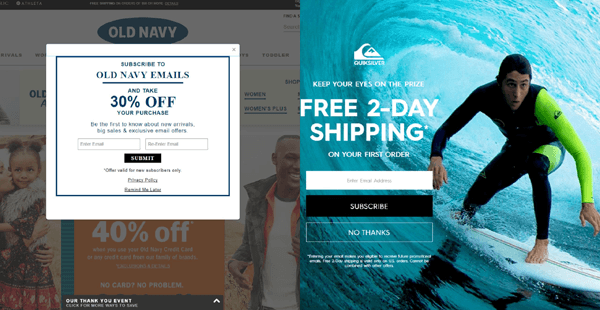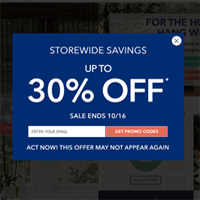Another Look at Lightbox Displays

The global cart abandonment rate for Q1 2017 is 75.6 percent, and unless retargeting is enabled for future websites and social networks these shoppers visit, a retailer's chance of them returning to complete a purchase is slim.
When an email address for this shopper is collected and he or she has consented to future communication from the brand, however, marketers have several ways to encourage purchase after browse or cart abandonment (and long after).
A common practice among retailers used to obtain email addresses for new or unregistered visitors is the deployment of lightbox displays containing incentives such as a percentage off or free shipping (see image). Lightboxes, overlays, popups and modals (some differences between them are noted further below) are not without their critics for the potentially negative impact on user experience, but the skepticism is often placed unfairly.

When lightboxes are leveraged using best practices (e.g., they are easy to close, forms are easy to fill out, they are relevant to the user), they are potentially valuable marketing tools to obtain email addresses and convert more visitors.
Website Magazine received a case study from 4Cite Marketing (a provider of real-time, triggered and direct mail marketing services) and Smith & Noble (a provider of custom window treatments), which outlined the latter's use of triggered lightboxes from 4Cite. Smith & Noble saw a 50 percent percent lift in its customer acquisition program, so we wanted to learn more - interviewing both Smith & Noble's digital marketing manager and 4Cite's senior vice president.
The Customer's Take
Roughly how long does it take for a typical Smith & Noble customer to convert?
Andrew Sampson, Digital Marketing Manager at Smith & Noble: Smith & Noble has a relatively long buying cycle - on average it takes 3-4 months for a prospect to turn into a buyer. To help monitor and move prospects through our conversion funnel we have "soft conversions" (precursor actions to purchasing) that include sampling our products and booking an appointment with us. Once someone has taken advantage of one of these free soft conversions, they are much more likely to purchase from us. We are also able to forecast a lead's estimated net demand very accurately once they have completed a soft conversion. 4Cite has been instrumental in increasing our soft conversion rate and reducing the average time to purchase by getting new traffic to our site engaging in soft conversions immediately.
In regard to the 50 percent lift in Smith & Noble's acquisition program, what conversions does that entail?
Sampson: Smith & Noble has seen a 50 percent lift in the number of new email subscribers each week due to the 4Cite lightbox (see image). In addition, 4Cite is able to re-engage and resubscribe a significant number of individuals that are unsubscribed in our email database. This re-engagement of inactive emails amounts to almost 10 percent of our total email address acquisition per week.
Once potential customers have entered their email address, what does the nurturing campaign look like from there?
Sampson: Once a potential customer enters their email address we immediately launch them into a custom nurturing campaign. First, we instantly provide them with whatever was promised in the lightbox whether that's a discount code, ebook, holiday checklist, etc.
The onboarding campaign then welcomes them to our newsletter and gives them insight into Smith & Noble's products and why they should work with us. We also introduce them to our services and push our free sampling hard.
Anything else you'd like to add?
Sampson: 4Cite has been a tremendous partner on many fronts.
One aspect I would like to highlight is the customer service. While their product and technology is top-notch, their service is even better.
The Vendor's Take
Is there a difference in lightbox effectiveness when comparing a retailer with a long purchase cycle (like Smith & Noble's) versus a shorter one?
Jack Sturn, SVP of 4Cite: Using triggered lightboxes to communicate with a website visitor is effective regardless of length of purchase cycle. The key is identifying each website visitor, effectively communicating, and then nurturing the opportunity with properly cadenced and relevant messaging.
What is a good balance and/or best practices for using triggered lightboxes to increase acquisition while still focusing on customer experience?
Sturn: First off, identification is key. You'll want to ask only new visitors to sign up for email, not already known customers - so best practice is to start off by identifying and excluding known customers. The next step is to time your request without coming across as too aggressive. Various strategies can be used; some retailers serve a lightbox immediately, while others wait for the visitor to be on the page a certain number of seconds. Others prefer to wait until a certain number of pages are viewed or when a user demonstrates exit intent. Since each brand's customers are different, we recommend that retailers test a few options to find the right balance between how long to wait vs. missing the opportunity because a visitor has left the site.
How a lightbox is displayed can also impact the customer experience. Techniques include modal lightboxes, which force the user to take action before they interact with the Web page, and engagement bars that do not force action. Engagement bars reflect a growing trend toward placing messaging at the perimeter of the page that remains visible as the user scrolls and interacts with the website. We recommend using lightboxes and engagement bars that can be minimized and maximized, letting the user essentially say "not right now" and choose to act on them later.
What are some best practices for using lightboxes responsibly for mobile users to avoid companies experiencing a Google penalty?
Sturn: Given the penalties that Google levies, best practice on a mobile device is to stay away from using a modal display and to keep your creative on a small portion of the screen. We recommend a tab with an offer to "sign up today" that expands into a data entry box.
Anything else you'd like to add?
Sturn: Considering how effective this technology is at acquiring new customers, and how easy it is to implement with a vendor like 4Cite, it's surprising how few retailers take advantage of it. In our recent study of 50 top retailers, only 30 percent used opt-in lightboxes or overlays.
In addition, of the retailers using this technology for email acquisition, some do a better job than others. It's important to not just accept any email entry that's made - you want good data, not just any data. In effect, garbage in, garbage out. The technology in place should be intelligent, refusing invalid email addresses and asking the user to re-enter a valid one. It should also be able to identify Web visitors in your unsubscribe file and ask them to resubscribe.
This technology is also valuable for much more than email acquisition. It can be used to identify known customers and make product recommendations and/or offers based on the visitor's value, profitability and potential profitability. In short, retailers should leverage recency, frequency, monetary value, product interests and channel preferences in their decisioning to engage with their customers, be relevant and drive revenue growth.
Website Magazine's Take








